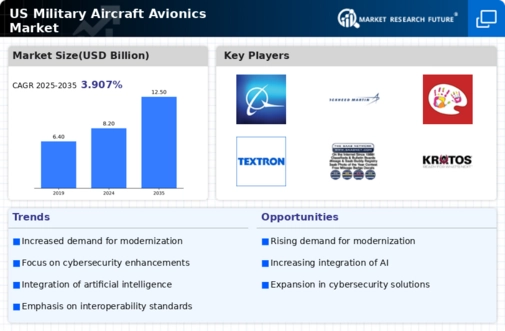Rising Defense Budgets
The military aircraft-avionics market is experiencing a notable boost due to increasing defense budgets. In recent years, the U.S. government has allocated substantial funds to modernize its defense capabilities, with a projected budget of approximately $740 billion for fiscal year 2025. This financial commitment is likely to enhance the procurement of advanced avionics systems, which are essential for improving aircraft performance and operational efficiency. As a result, manufacturers in the military aircraft-avionics market are expected to benefit from heightened demand for innovative technologies that support mission readiness and effectiveness. Furthermore, the emphasis on upgrading existing fleets and integrating new systems is anticipated to drive growth in this sector, as military forces seek to maintain a competitive edge in an evolving global landscape.
Integration of Artificial Intelligence
The integration of artificial intelligence (AI) into avionics systems is emerging as a transformative driver within the military aircraft-avionics market. AI technologies are being increasingly adopted to enhance decision-making processes, automate routine tasks, and improve data analysis capabilities. This trend is particularly relevant in the context of advanced military operations, where real-time data processing and rapid response times are critical. The U.S. Department of Defense has recognized the potential of AI, allocating significant resources to develop and implement AI-driven solutions in military aircraft. As a result, the military aircraft-avionics market is likely to witness a surge in demand for AI-enabled systems that can optimize flight operations, enhance mission planning, and improve overall aircraft performance. This shift towards AI integration may redefine operational paradigms and create new opportunities for innovation in the sector.
Emerging Threats and Geopolitical Tensions
The military aircraft-avionics market is significantly influenced by new threats and geopolitical tensions. As global security dynamics shift, the U.S. military is compelled to adapt its strategies and capabilities to address potential adversaries. This has led to an increased focus on advanced avionics systems that enhance situational awareness, targeting precision, and overall mission success. For instance, the rise of unmanned aerial vehicles (UAVs) and advanced fighter jets necessitates sophisticated avionics solutions to ensure operational superiority. Consequently, defense contractors are likely to invest heavily in research and development to create cutting-edge technologies that can effectively counter these evolving threats. The military aircraft-avionics market is thus positioned for growth as defense agencies prioritize investments in systems that bolster national security.
Increased Collaboration with Private Sector
The military aircraft-avionics market is witnessing a trend of increased collaboration between government entities and the private sector. This partnership is driven by the need for rapid innovation and the development of advanced technologies that can meet the evolving demands of military operations. The U.S. government has initiated various programs to foster collaboration with defense contractors, startups, and technology firms, aiming to leverage their expertise in avionics and related fields. Such collaborations are likely to accelerate the development of next-generation avionics systems, enhancing capabilities in areas such as communication, navigation, and surveillance. As a result, the military aircraft-avionics market is expected to benefit from a more dynamic and responsive innovation ecosystem, ultimately leading to improved operational effectiveness and mission success.
Focus on Sustainability and Environmental Compliance
The military aircraft-avionics market is increasingly influenced by sustainability and environmental compliance. As the U.S. military seeks to reduce its carbon footprint and adhere to environmental regulations, there is a push towards developing avionics systems that are more energy-efficient and environmentally friendly. This includes the adoption of alternative fuels, lightweight materials, and advanced energy management systems. The U.S. Department of Defense has set ambitious goals to achieve net-zero emissions by 2050, which is likely to drive innovation in the military aircraft-avionics market. Manufacturers are expected to invest in research and development to create sustainable avionics solutions that align with these objectives. Consequently, this focus on sustainability may not only enhance operational efficiency but also improve the public perception of military operations.

















Leave a Comment